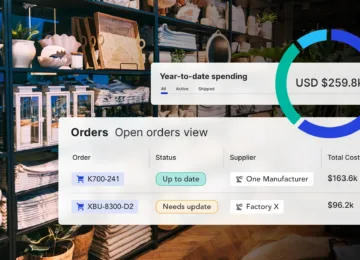Dan Magida has spent over three years building and managing supply chain operations which ranged from manufacturing to fulfillment for a high-growth DTC brand. Currently, he is helping companies grow and expand their existing and new product lines at Anvyl.
If you were to ask business owners whether or not they thought inventory management was an important part of their company’s success, most of them would probably nod their head and say yes—of course, inventory management is important. After all, how can you expect to run a business if you don’t know how much product you have on hand? These business owners will then proudly show you their fully built out Inventory Management System (or IMS).
But, what if it isn’t necessary? What if there are already multiple avenues of receiving inventory data that give you the information you need without duplicating work efforts?
As it turns out, you can manage your inventory effectively without a traditional IMS. This is because other nodes within your supply chain are already doing all the work for you!
The Fulfillment Center: Your One-Stop Reports Shop
A good fulfillment center sends daily reports on sales, returns, scrappage. They can even send alerts when your inventory gets below a critical point. These reports are aggregated by SKU number and can be broken down a level further by lot number. Really, a fulfillment center can double as one part of your IMS because they inherently track all the finished goods data points that an IMS would normally aggregate and compile.
Even better, if you are not a fan of the daily CSV files from your fulfillment center that bombard your email at one in the morning, there are other solutions listed below where data integrity stays intact and can be utilized across channels.
Other Sources of Inventory Data
If the reports generated by your fulfillment center weren’t enough, what about your warehouse or manufacturer? If you are operating off a just-in-time inventory model this may not completely apply to you. However, warehouses and manufacturers that store or fill product must perform these usage reports. These audit reports are broken out by SKU and BOM after every production run or transfer of materials for you to review. This information is critical for your finance team as it can transfer pre-finished goods into finished goods or provide a degradation cost that wouldn’t have been known previously. All the data compiled and verified by the sender, ready for you to use.
One key element that is often overlooked is purchasing data. In order for the fulfillment center to process the order, there must receive the in-flow of data through a point of sale system. Shopify, Sellics, SPS Commerce are a few of them that already provide real-time sales visibility. Between your sales system, warehouse, manufacturer, and fulfillment center, is there really any other data you could ask for that an IMS doesn’t provide?
Bottom line, by using an IMS, you may be duplicating data and efforts that are already being done for you elsewhere. Time is valuable and at early stages of a company’s existence, this could not ring truer if other nodes are already accomplishing the work for you, why not take one more thing off your to-do list?
Data Validation
If you are using an IMS, odds are that your systems takes into account all of the same data being produced by those sources above and aggregating them into its own system. Before any of that information can be used by the IMS to help you make decisions on inventory, it must be validated. Which data points are duplicates? What is the discrepancy between the reports and actual inventory? How does the data need to be portrayed and formatted to be usable? All of these are problems being created by the IMS itself and can therefore be mitigated simply by skipping the IMS and going straight to the source.
Instead of relying on an IMS, you can build the same internally. Fulfillment centers are already set up through API or EDI connections, why not send that data into your backend database such as SQL schema or Business Intelligence (BI) tool? The majority of warehouse or manufacturing reports gathered today are through CSV or PDF and formatting in its own unique way. There is not one system of record consistent across the board. Pulling the data from the CSV or PDF adds an element of duplication. Why duplicate this work in an IMS system. The data can be stored on a Microsoft Access and be pushed daily to your own server. Instead of manually entering. That way, all of your inventory data can live internally as opposed to going through the middle-man of the IMS.
The data is already out there and yours for the taking. All you must do is flow it into your own, internal backend system and it’s ready to go, all in one place, no IMS required.
Forecasting
Even with the use of an IMS system, forecasting doesn’t take place inside this tool. Forecasts are unique and each business has their own set of rules that they follow.
By using the backend system that your data inputs to (such as SQL or a BI tool), you already have the tools you need to make accurate forecasts on a BOM basis. By looking at historical data points on Minimum Order Quantities, freight volume and weight data, and inventory numbers, SQL (and many BI tools) already has the capability of running the statistics to show past trends. These data points can be sent automatically and updated into an excel sheet for real-time analysis. In addition, forecasting can be performed and maintained directly in your SQL server as performed previously.
Cost
There are multitudes of IMS platforms out there with varying degrees of features. Many of the ones with the features necessary to manage your inventory effectively can cost upwards of $200 and are priced on a per user, per month basis. Add to that cost the fact that your data is typically residing with a third party as opposed to living internally on your own systems.
While there are many good reasons to rely on third-party platforms for your supply chain needs, when it comes to inventory management it makes sense to cut out the cost and effort that comes with an IMS and to manage inventory yourself with the data already being provided to you.
Get Ahead of the Inventory Game
How does your company manage inventory? If you rely on an IMS, what is the experience like? Do you think it could be made simpler and faster? In a world where efficiency is the key to success, businesses are increasingly understanding how simple inventory management can be and are cutting out the middleman. However, over fifty percent of American small and mid-size businesses are still relying on an IMS. By innovating now and understanding how to manage inventory data internally, you can get ahead of the curve and set yourself up for success.
Have you forgone using an IMS? Let us know in the comments below.
To learn more about Anvyl, sign up for a personalized demo of our platform today.



